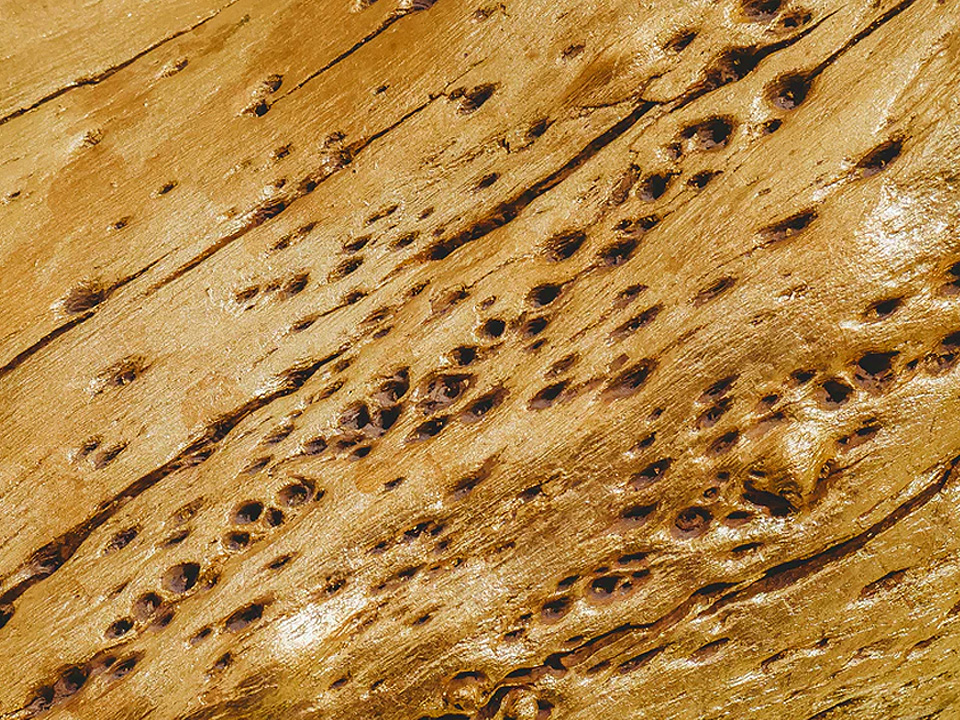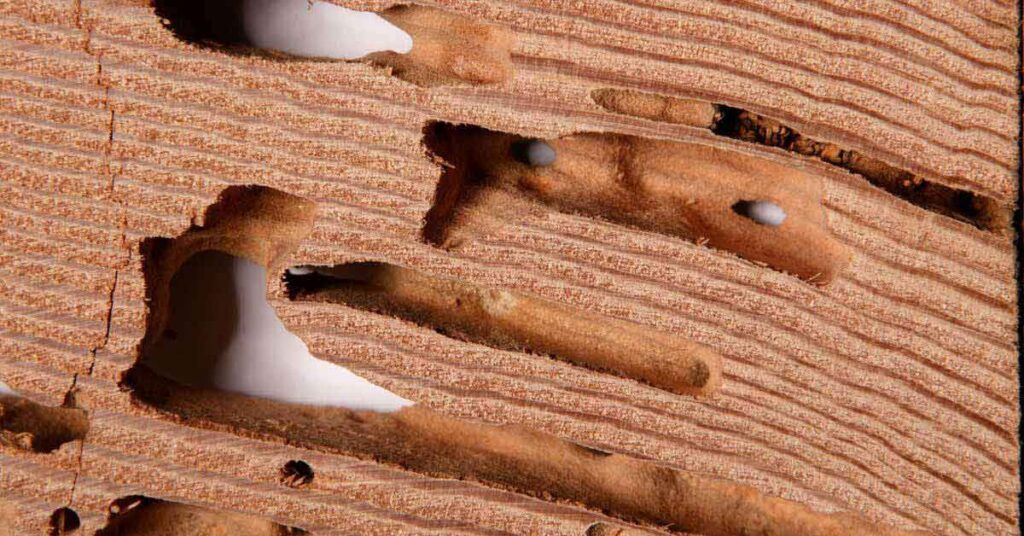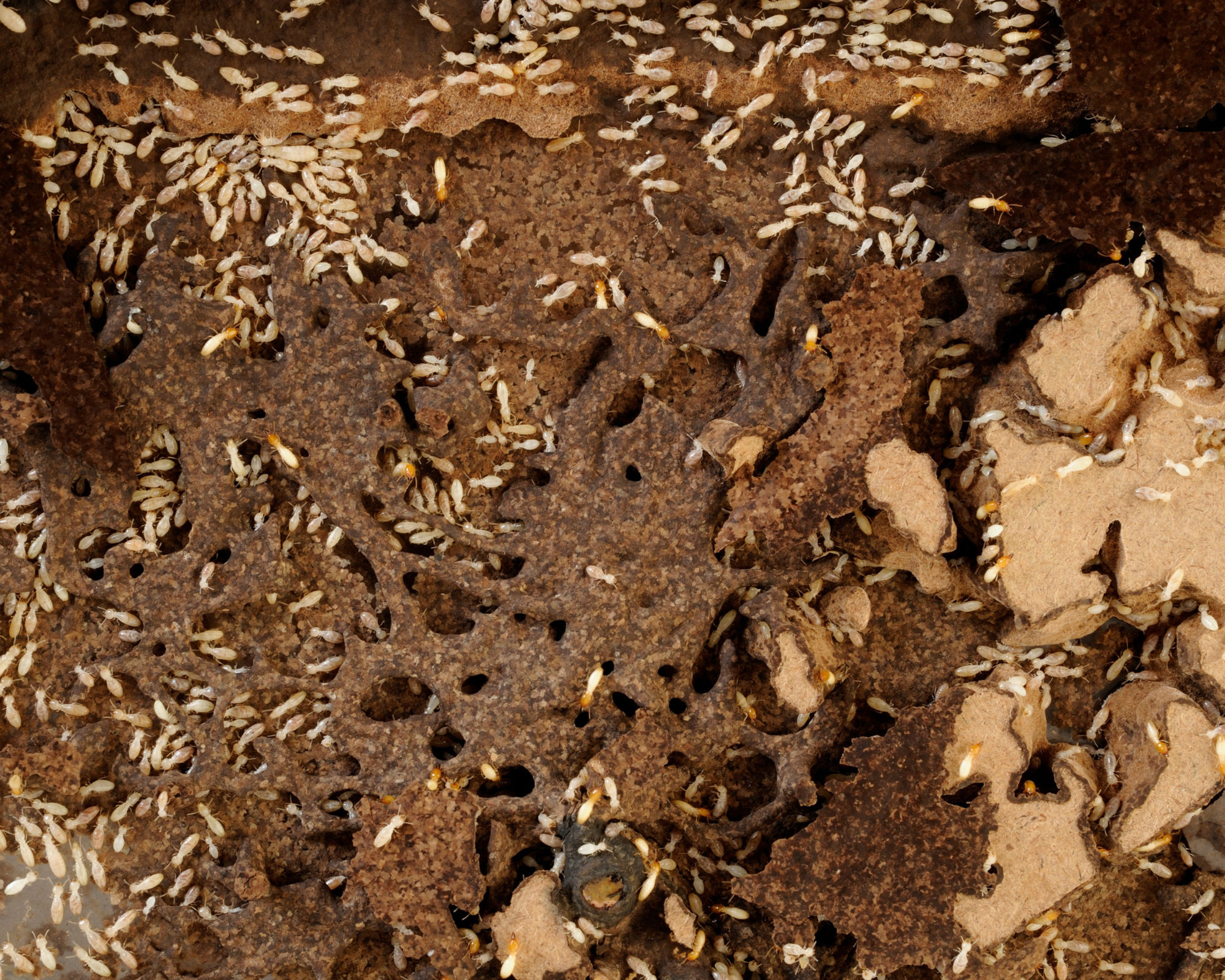Termite holes typically appear as small, round openings in wood or other materials, often the size of a pinhead, and may lack a distinct pattern, occasionally resembling tiny nail holes.
Let’s come to the details of what termite holes look like.
What do termite holes look like – Let’s Reveal the Fact
When you’re trying to identify termite holes, it’s essential to pay attention to their physical characteristics. Here’s what you need to know:
- Physical description of termite holes
- Termite holes typically appear as small openings in wood or other materials. They can range in size from 1/32 of an inch to 1/8 of an inch (0.8 mm to 3.2 mm) in diameter.
- These holes are often round or oval-shaped and can be found on the surface of the infested material.
- The holes may look like tiny tunnels or channels that termites create as they chew through wood or cellulose-based materials.
- Sometimes, small piles of powdery wood-like material might be near these openings. This is often referred to as “termite frass” and consists of digested wood and termite feces.
- Variations in size and shape based on termite species
Different termite species can create holes of varying sizes and shapes. For example:
Subterranean termites: These termites usually create smaller holes, often less than 1/16 of an inch (1.6 mm) in diameter. Their holes can look like tiny dots on the surface of the wood or maybe concealed beneath layers of paint or other materials.
Drywood termites: Drywood termites are known for creating larger and more noticeable holes, ranging from 1/16 to 1/8 of an inch (1.6 mm to 3.2 mm). These holes are often visible on the surface and are accompanied by piles of termite frass.
Formosan termites: Formosan termites are particularly destructive and can create irregularly shaped holes that are larger than those made by other species. These holes may be several millimeters wide and can penetrate deep into the wood.
Location of termite holes

When you’re searching for termite holes, it’s crucial to know where to look. Here’s a breakdown of where you might find them and signs of termite activity in different parts of a property:
a. Common areas where termite holes can be found:
Wood Structures: Termite holes are most commonly found in wooden structures. Check wooden beams, furniture, and flooring for small openings resembling tiny tunnels or channels.
These holes may be on the surface or hidden beneath layers of paint or other materials.
Walls: Termites can also infest the walls of your home. Look for termite holes in drywall or plaster, which can appear as small cracks or openings. Sometimes, you might see termite mud tubes extending from the ground to the walls as an indicator of their presence.
Foundation: The foundation of your property is another area where termites can create openings. Inspect the foundation walls and any wooden components for termite holes or mud tubes.
b. Signs of termite activity in different parts of a property:
Indoors: Inside your property, besides termite holes, keep an eye out for damaged or hollow-sounding wood. Termite-damaged wood may sound dull and hollow when tapped, and it can be easily punctured with a screwdriver or similar tool.
Outdoors: Outdoors, look for mud tubes running along the exterior walls of your home. Subterranean termites make these mud tubes to travel between their nests and food sources.
Additionally, check for discarded wings near windowsills and doors, as termites shed their wings after swarming.
Basement and Crawl Spaces: Termite activity is often first detected in basements or crawl spaces. During inspections, check wooden support beams and structures for termite damage or mud tubes.
Garden and Yard: Termites can also infest your yard’s wooden fences, tree stumps, and other wooden structures. Examine these areas for termite holes, damage, or mud tubes.
In conclusion, termite holes and signs of termite activity can be found in various parts of your property, especially in wooden structures and areas with cellulose-based materials.
Differentiating termite holes from other similar marks
When you’re trying to identify termite holes, it’s important to distinguish them from other marks left by various wood-related culprits.
Here’s a guide to help you tell termite holes apart from carpenter ants, woodpecker damage, and other wood-boring insects:
a. Comparison of termite holes with carpenter ants, woodpecker damage, and other wood-boring insects:
Carpenter Ants: Carpenter ants create openings in wood, similar to termites. However, their holes tend to be larger, often exceeding 1/4 inch (6.4 mm) in diameter.
This can weaken buildings, making them unsafe due to compromised structural integrity over time. You may also find sawdust-like material (frass) near carpenter ant openings.
Woodpecker Damage: Woodpeckers can cause holes in wood, but their holes are typically irregular in shape and have a more jagged appearance. These holes are usually larger and deeper than termite holes, and you might notice wood chips or splinters around them.
Other Wood-Boring Insects: Some beetles and other wood-boring insects can leave exit holes when they emerge from infested wood. These exit holes are often round or oval but can vary in size.
The key difference is that these holes are typically the result of the insects leaving the wood, whereas termite holes are entrances into the wood for feeding.
b. The unique characteristics of termite holes for easy identification:
To identify termite holes with confidence, focus on their unique characteristics:
Small and Uniform: Termite holes are typically small and consistent in size, ranging from 1/32 to 1/8 of an inch (0.8 mm to 3.2 mm) in diameter. They often have a round or oval shape.
Smooth Edges: Termite holes usually have smooth edges without splinters or jagged surfaces.
Accompanied by Frass: Look for piles of powdery, grainy material near termite holes. This termite frass is a distinctive sign of termite activity.
Location: Consider the location of the holes. Termites tend to infest wood from the inside out, so the holes are usually on the surface or just beneath it. In contrast, woodpecker damage may penetrate deeper into the wood.
By paying attention to these unique features, you can more easily differentiate termite holes from marks left by other wood-related issues, helping you take appropriate action if you suspect a termite infestation.
Why are termite holes a cause for concern?
Understanding why termite holes are a cause for concern is crucial. Here’s an explanation of the damage caused by termites and the impact of termite infestations on property value and structural integrity:
a. Overview of the damage caused by termites:
Termites are silent but highly destructive pests. They cause damage by feeding on the cellulose found in wood and other cellulose materials. This feeding activity leads to:
Structural Damage: Termites can weaken wooden structures, including support beams, floor joists, and wall studs. This can weaken buildings, making them unsafe due to compromised structural integrity over time.
Costly Repairs: Repairing termite damage can be expensive, often involving the replacement of damaged wood and extensive renovation work.
Aesthetic Damage: Termite damage can also mar the appearance of your property. Walls, floors, and ceilings may develop unsightly cracks, sagging, or bulges.
Safety Hazards: In severe cases, termite damage can lead to safety hazards, such as collapsing floors or ceilings.
b. The impact of termite infestation on property value and structural integrity:
Property Value: Termite infestations can significantly reduce the value of your property. Prospective buyers are often wary of purchasing homes with a history of termite problems. This can make it challenging to sell your property at a desirable price.
Insurance Issues: Many insurance policies do not cover termite damage, which means homeowners may have to bear the full cost of repairs.
Long-term Costs: Ignoring termite infestations can escalate costs for repairs and treatments. It’s financially prudent to address the issue promptly.
Structural Stability: The longer a termite infestation goes untreated, the greater the risk to the structural stability of your home. In severe cases, it may lead to extensive and costly structural repairs.
In summary, termite holes clearly indicate termite activity, and their presence is a significant cause for concern. Subterranean termites use these tubes for protection while moving between their nests and food sources.
Detecting termite holes: Signs to watch out for
To detect termite holes effectively, it’s essential to be vigilant and use the right tools. Here’s how to spot signs of termite activity and employ inspection tools to uncover hidden termite holes:
a. Indications of a termite colony nearby:
Swarmer Termites: Keep an eye out for termite swarmers, which are winged termites that emerge from colonies to start new ones. Swarming termites are often an early sign of an established termite colony nearby.
Mud Tubes: Look for mud tubes on walls, foundations, or other surfaces. Subterranean termites use these tubes for protection while moving between their nests and food sources.
Termite Frass: Check for small piles of termite frass, which is a powdery substance resembling sawdust near potential entry points or termite holes.
Damaged Wood: Inspect wooden structures for signs of damage, such as hollow-sounding wood, weakened support beams, or crumbling wood. Termite-damaged wood may also have cracks or grooves.
Discarded Wings: After swarming, termites shed their wings, so look for discarded wings around windows, doors, or light fixtures.
b. Use of inspection tools (e.g., flashlight, probing tool) to uncover hidden termite holes:
Flashlight: A flashlight is your ally in the hunt for termite holes. Shine it along walls, floors, and wooden surfaces to reveal hidden holes or mud tubes. Termites often operate in dark, concealed areas, so good lighting is essential.
Probing Tool: A probing tool, such as a screwdriver or a knife with a narrow blade, can be gently used to investigate suspected termite holes. Insert the tool into the suspected hole to see if it penetrates the wood easily or encounters tunnels within. Be cautious not to damage the wood further.
Magnifying Glass: Use a magnifying glass to scrutinize termite holes and frass more closely. Termites are small insects so that a magnifying glass can reveal their presence more clearly.
Moisture Meter: Termites are attracted to moisture. A moisture meter can pinpoint areas with high humidity or moisture, where termites might be more active, aiding in identification.
Professional Inspection: If you’re uncertain about your findings or want a thorough assessment, consider hiring a professional pest control expert. They have specialized tools like borescopes and infrared cameras to detect hidden termite activity.
What to do if you find termite holes?

Discovering termite holes can be concerning, but taking the right steps is crucial. Here’s what you should do if you find termite holes:
a. Steps to take upon discovering termite holes:
Do Not Disturb: Avoid disturbing the suspected termite holes or attempting to treat the infestation on your own. Disturbing termites may cause them to relocate, making it more challenging to locate and treat the colony effectively.
Take Clear Photos: Use your smartphone or camera to take clear photos of the termite holes, any mud tubes, termite frass, or damaged wood. This documentation can be helpful when seeking professional assistance.
Isolate the Area: If possible, limit access to the infested area to prevent further disturbance and damage. Termites can spread to other parts of your property if disturbed.
Contact Pest Control: Reach out to a licensed pest control professional or termite exterminator. They have the expertise and equipment to accurately assess the extent of the infestation and recommend an appropriate treatment plan.
b. Seeking professional assistance for proper diagnosis and treatment:
Inspection: The pest control expert will inspect your property thoroughly to find out how bad the termite problem is, locate the nest or colony, and check the damage.
Treatment Options: Based on their findings, the professional will recommend treatment options tailored to your specific situation. Treatment may involve the use of liquid termiticides, bait systems, or fumigation, among other methods.
Regular Inspections: After treatment, your pest control expert may recommend regular inspections to ensure the infestation is completely eradicated and prevent future termite problems.
Repair Recommendations: Depending on the extent of damage, the expert may suggest repairs to damaged wood or structures. Addressing structural issues is vital for maintaining the integrity of your property.
Preventative Measures: To prevent future infestations, the professional may advise on preventive measures, such as maintaining proper drainage, reducing moisture around your property, and ensuring that wood-to-soil contact is minimized.
Preventing termite infestation
To protect your property from termite infestations, it’s essential to take proactive measures. Here are effective prevention methods and maintenance tips:
a. Effective prevention methods to safeguard your property:
Regular Inspections: Schedule regular termite inspections by a professional pest control expert. They can detect early signs of termite activity and take preventive measures.
Termite Barriers: Install physical or chemical termite barriers around your property. Physical barriers, like stainless steel mesh, prevent termites from entering through cracks in your foundation. Chemical barriers involve treating the soil around your home with termiticides.
Reduce Moisture: Termites are attracted to moisture. Fix any plumbing leaks, ensure proper drainage away from your foundation, and use dehumidifiers in damp areas like basements and crawl spaces.
Wood-to-Soil Contact: Minimize direct contact between wooden structures and soil. Elevate wooden structures and keep them at least 6 inches above the ground. Ensure that tree branches and shrubs do not touch your home, as they can provide a bridge for termites.
Ventilation: Maintain good ventilation in attics, basements, and crawl spaces to reduce humidity levels, making these areas less attractive to termites.
Seal Cracks: Seal cracks and crevices in your home’s foundation, walls, and roof. Termites can enter through tiny openings.
Remove Dead Wood: Remove dead trees, tree stumps, and wood debris from your yard, as these can attract termites.
Proper Storage: Store firewood, lumber, and other cellulose-based materials away from your home and off the ground. Use a raised platform or rack to keep them dry and termite-free.
b. Maintenance tips to minimize the risk of termites:
Regular Maintenance: Keep your property well-maintained, including repairing leaky pipes, broken roof tiles, and damaged gutters promptly.
Landscaping: Maintain a clean and well-kept yard. Trim overgrown shrubs and trees to prevent them from touching your home.
Mulch: If you use mulch in your garden, choose termite-resistant options like rubber or gravel instead of wood-based mulch.
Outdoor Wood: If you have wooden structures outdoors, like fences or decks, treat them with termite-resistant chemicals or paints.
Monitor for Signs: Regularly check your property for termite signs like mud tubes, frass, or damaged wood.
Education: Educate yourself and your family about the signs of termite infestation and what to do if you suspect an issue.
Using these prevention methods and maintenance tips can greatly lower the risk of termite infestations and safeguard your property from expensive damage.
FAQs
What do termite holes look like?
Termite holes typically appear as small, round openings in wood or other materials. They are often very tiny, about the size of a pinhead.
Are termite holes always visible?
No, termite holes are not always visible because termites often build tunnels and galleries inside the wood, concealing the entry points.
Do termite holes have any specific patterns?
Termite holes usually lack a distinct pattern but can be clustered together, appearing as multiple small openings on the surface.
Can termite holes be mistaken for nail holes or other damage?
Yes, termite holes can be mistaken for nail holes or other damage, especially if they are small and not accompanied by other signs of termite activity.
Do termite holes produce sawdust or frass?
Some termite species produce tiny pellets or frass as they excavate wood, which may be found near or inside the holes.
Are termite holes a sign of an active infestation?
Yes, termite holes can indicate an active infestation if they are recent and not old or weathered.
Can I seal termite holes to prevent further infestation?
No, sealing termite holes is not an effective method to prevent further infestation; it’s essential to address the underlying termite issue with professional treatment.
How can I confirm termite activity if I see holes?
If you suspect termite activity due to holes, it’s essential to consult a pest control professional for a thorough inspection to confirm the infestation.
Do all termite species create holes in wood?
No, not all termite species create visible holes in wood; their behavior can vary, and some may have less noticeable entry points.
What should I do if I find termite holes in my home?
If you find termite holes or suspect termite activity, it’s crucial to contact a pest control specialist promptly for a professional assessment and treatment if necessary.
Conclusion
Termite holes are small openings in wood or other surfaces that indicate the presence of termites. These holes are typically tiny and often look like small tunnels or tunnels filled with mud or soil.
Recognizing termite holes is crucial as it allows for early detection and prevention of further damage to your property.
Protecting your property from termite damage, regular inspection of wooden structures, keeping moisture levels low, and seeking professional help are essential proactive measures.
Taking action early can prevent expensive repairs and structural damage from termites.

